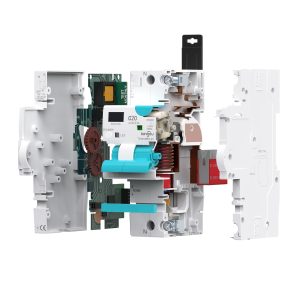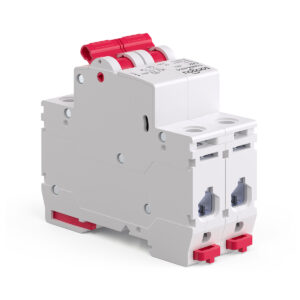
RCBO Trips at Night? Causes, Diagnosis, and Lasting Fixes
RCBO Trips at Night? Causes, Diagnosis, and Lasting Fixes Already know what an RCBO is? Great. This page skips the basics and focuses on nocturnal
Have you ever touched your electrical panel and noticed one of the circuit breakers feels warm, or even hot? While a slightly warm breaker might not be immediately alarming, a very hot breaker that isn’t tripping can be a cause for serious concern. “Why is my circuit breaker getting hot but not tripping?” This is a critical question to address, as it can indicate underlying electrical issues that could pose safety hazards in your home.

Before we dive into the issue of overheating, let’s quickly review the basics of circuit breakers and their crucial role in your electrical system. A circuit breaker, also known as a breaker or trip switch, is an essential safety device in modern electrical systems. Its primary function is to automatically interrupt the electrical circuit when abnormal conditions like overloads, short circuits, or ground faults occur. This prevents excessive current flow, which can lead to fires, equipment damage, and even electrical shocks.
Imagine a scenario without circuit breakers. If an appliance malfunctions and draws excessive current, the electrical wires could overheat, melt, and potentially ignite surrounding flammable materials, causing a devastating fire. Circuit breakers act as the guardians of your home’s electrical system, constantly monitoring the circuit’s safety and stepping in to protect your life and property when danger arises.
To some extent, it’s normal for circuit breakers to generate some heat during operation. As electricity flows through the internal components of a breaker, it encounters resistance, producing heat – similar to how a light bulb generates heat when it illuminates. Slight warmth is usually not a cause for concern.
However, if a circuit breaker becomes excessively hot to the touch, feels burning hot, or is accompanied by other unusual signs like burning smells, buzzing sounds, or flickering lights, it is definitely not normal and requires immediate attention. Excessive heat can indicate underlying electrical problems, and ignoring it can lead to serious consequences.
This is often the most perplexing question: Why is the breaker hot but hasn’t tripped to cut off the power? There are several potential reasons for this, and we’ll explore them in detail:
Mild Overload:
This is one of the most common culprits. When a circuit is slightly overloaded, meaning it’s drawing more current than the breaker’s rated capacity, the breaker will start to heat up. This overload might not be severe enough to trigger an immediate trip, but prolonged mild overloading can cause continuous heating.
——Reasoning: Circuit breaker tripping mechanisms require a certain amount of time to respond to overloads. A mild overload may not reach the tripping threshold quickly, but it will generate heat continuously.
——Common Scenarios: Simultaneously using multiple high-wattage appliances on the same circuit, such as air conditioners, space heaters, hair dryers, etc., exceeding the circuit’s capacity.
Loose Connections:
Loose connections between the circuit breaker and electrical wires create resistance in the electrical path. This increased resistance generates heat as electricity attempts to flow through the constricted connection. Loose connections are not only a cause of breaker overheating but also a potential fire hazard due to electrical arcing.
——Reasoning: Electricity encounters higher resistance at loose connections, converting electrical energy into heat.
——Common Scenarios: Improper installation, vibrations over time, or loose screws can lead to loose connections at the breaker terminals.
Aging or Faulty Breaker:
Circuit breakers have a lifespan. Over time, internal components can degrade, wear out, or become faulty due to manufacturing defects or general wear and tear. An aging breaker may not dissipate heat effectively, or its tripping mechanism may become sluggish or even fail completely.
——Reasoning: Degradation of internal components can impair the breaker’s performance, reducing its heat dissipation capacity and tripping sensitivity.
——Common Scenarios: Breakers that are very old, have been tripped frequently over their lifespan, or are of poor quality may be prone to failure.
High Ambient Temperature:
The ambient temperature surrounding the circuit breaker can also affect its ability to dissipate heat. If the breaker box is located in a poorly ventilated area, direct sunlight, or a hot environment like an attic, the breaker’s base temperature is already elevated, making it more susceptible to overheating.
——Reasoning: Higher ambient temperatures reduce the breaker’s efficiency in shedding heat, leading to heat buildup.
——Common Scenarios: Breaker boxes installed in attics, sunrooms, or other areas prone to high temperatures, especially during summer months.
Internal Component Issues:
Problems within the circuit breaker’s internal components, such as the bimetallic strip or electromagnetic coil, can also lead to overheating. For instance, a deformed bimetallic strip might cause delayed or failed tripping.
——Reasoning: Faulty internal components directly impact the breaker’s functionality and heat dissipation characteristics.
——Common Scenarios: Manufacturing defects, physical damage to the breaker, or corrosion inside the breaker can cause component failures.
Circuit breaker overheating is not a minor issue to ignore; it poses significant dangers:

Fire Hazard: Overheated breakers can ignite nearby dust, insulation, or other flammable materials, leading to electrical fires. Electrical fires are notoriously difficult to extinguish and extremely dangerous.
Equipment Damage: Excessive heat accelerates the degradation of the breaker’s internal components, potentially causing them to melt, warp, or fail completely. This renders the breaker ineffective in providing protection.


Melted Wire Insulation: Breaker overheating can also cause the connected wires to overheat, melting the wire insulation. This can lead to short circuits, electrical shocks, and further fire risks.
Performance Degradation: Even without immediate incidents, prolonged overheating diminishes the breaker’s performance, reducing its tripping sensitivity and its ability to protect the circuit effectively when needed.

Therefore, upon discovering an overheated circuit breaker, it is crucial to take immediate action to identify the cause and resolve the problem. Never take this issue lightly!
Prevention is always the best strategy. Here are some tips to help prevent circuit breaker overheating:
Plan Your Electrical Usage: Understand the load capacity of your circuits and avoid overloading them.
Avoid Simultaneous High-Wattage Appliance Use: Stagger the use of high-power appliances to prevent overloading circuits.
Regular Electrical System Inspections: Periodically inspect your breaker box, wiring, outlets, and other electrical components to ensure connections are secure and there are no signs of aging or damage.
Choose Quality Electrical Products: When purchasing breakers, wiring, and other electrical components, opt for reputable brands and quality products, such as [Tongou] (www.tongou.com) for reliable performance and safety. (Reiterate your brand and website)
Regular Maintenance: Keep your breaker box clean and free of dust, and ensure adequate ventilation around it.
Pay Attention to Warning Signs: Be alert for signs of electrical problems like flickering lights, appliance malfunctions, or unusual odors, and investigate them promptly.
If your home’s circuit breakers have developed any of these problems, it’s time to replace them.
Tongou is worth your trust and choice. Whether it’s a smart breaker or a regular breaker, they can meet your needs in different ways.
With 30 years of experience in circuit breaker production and manufacturing, we can meet customized needs and look forward to your support.
Q: Is it normal for a circuit breaker to be slightly warm?
A: Yes, a slightly warm breaker is usually normal. However, if it’s very hot or burning to the touch, it’s not normal.
Q: My breaker is hot but not tripping. Is it safe to continue using it?
A: Strongly discouraged! A hot breaker that isn’t tripping indicates an underlying problem. Continuing to use it could lead to more severe issues, including fires.
Q: Can I replace a circuit breaker myself?
A: If you have professional electrical knowledge and experience and strictly adhere to safety procedures, you can replace a breaker yourself. However, if you are unsure, it is highly recommended to hire a qualified electrician. Incorrect installation can lead to electrical shock or system malfunctions.
Q: How often should I inspect my breaker box?
A: It’s recommended to inspect your breaker box at least annually, especially before periods of high electrical demand (like summer and winter).
Q: Where can I buy reliable circuit breakers?
A: You can choose [Tongou Electric Brand] (www.tongou.com) circuit breaker products or purchase from reputable electrical supply stores that carry well-known brands to ensure quality and safety.

RCBO Trips at Night? Causes, Diagnosis, and Lasting Fixes Already know what an RCBO is? Great. This page skips the basics and focuses on nocturnal

MCB B/C/D Curves in Practice: How Inrush Current Shapes Your Choice This guide assumes you already know what an MCB is. If you need a

SPD Coordination for Solar PV and EV Charging: Where to Place Type 1/2/3 Already know the difference between Type 1/2/3 and AC vs DC SPDs?

MCB vs MCCB: A Practical Guide to Icu/Ics and IEC 60898 vs 60947-2 This guide assumes you already know what a breaker is. If you

tongou was established in 1993 and is the trademark of Changyou Technology. We position ourselves as providers of intelligent product solutions for high and low voltage electrical systems, taking on solving customers’ pressures and challenges as our responsibility and creating value for them. We utilize intelligent products to serve global customers, making life smarter and more convenient to benefit your life.
Paidong Industrial Zone Qiligang,Yueqing City,Zhejiang province,China.
Sales: [email protected]
After-sales: [email protected]
© 2025 Changyou Technology. All Rights Reserved.

